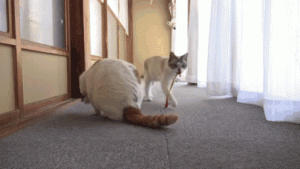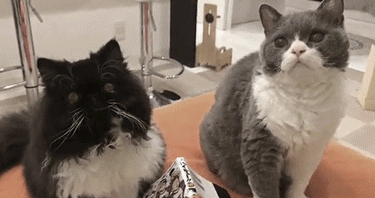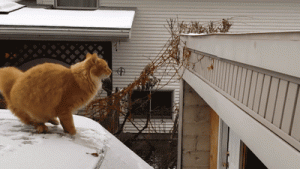Although all the sisters in the editorial team have cats, Xiao Yijia’s cat Dafu has a skill that few other cats possess… and that is patrolling! After work, you can just sit on the sofa and play with your cat—no need for the cat owner to turn playtime into a full-on workout. This made all the other sisters incredibly envious! But why do some cats naturally patrol while others don’t? And how exactly can this skill be developed?
-
What is “Patrolling”?
Patrolling, simply put, is when a cat picks up something you throw and brings it back! Yes, you read that right! This skill, often associated with dogs, can actually be learned by many cats too. For example, besides patrolling balls, cats might also retrieve other objects—like stick-shaped toys, springs… or even some things you’d rather not see. So, how many cats actually have this patrolling behavior? Here’s a survey study about these clever kitties—let’s dive in!
-
The Little Secrets of Patrolling Cats
Finding 1: Most cats are self-taught. 94% of owners reported that before their cat started patrolling, they had not done any formal training. In other words, the cats figured it out themselves! Oh, what smart little furballs!Finding 2: Cats learn to patrol best when they are young. Just like humans, learning early seems to matter. 841 owners said their cats started patrolling before turning 1 year old, though a few claimed their cats only learned after age 16—late bloomers, perhaps?Finding 3: Cats have preferences for what they like to patrol. Each cat has its favorite item, though most prefer their toys. Interestingly, a small number even like to “retrieve trash”!Finding 4: Not all cats in the same household patrol. Many multi-cat owners think that if one cat learns a skill, it will naturall.Researchers analyzed these survey responses and classified cat patrolling behaviors into three types:Innate behavior: Cats learn from daily experience, similar to how a cat carries prey or how mother cats bring kittens back to the nest.Trained behavior: Behavior shaped deliberately by humans to create a patrolling reflex.Opportunistic behavior: Actions that occur occasionally by chance.So it seems that patrolling skills might be written in every cat’s DNA—but some cats simply haven’t decided to show them yet. We can try to help bring them out.

-
Tips for Training Patrolling
Step 1: Overall Setup.Start in an empty room (no distractions), and choose a time before the cat’s mealtime (to increase motivation with food). Use the same toy consistently (to reinforce signals). Break the patrolling process into four parts: chase, bite, pick up, return, and focus on whichever part the cat needs to practice.Chase: Let the cat watch you throw the toy to a visible spot. Repeat until the cat starts chasing it on its own, then reward it.Bite: Use a small ball that can hold treats. Let the cat get used to biting and holding it. Reward when it does.Pick Up: First, teach the cat to pick up the toy from your hand, gradually lower the hand, and eventually let the cat pick up the toy from the floor. Reward whenever the cat picks it up.Return: Give the cat a reason to approach you (like placing a treat on a plate). Then place the toy on the plate and have the cat pick it up and put it back. Reward each successful attempt. Move the toy further away gradually and repeat.Once the cat can complete all four steps smoothly, remove the plate and try the full patrolling exercise. Always remember: reward your cat when it completes the task!
If your cat is full of energy, loves parkour, and enjoys interacting with humans, there’s a very high chance that they could become the next “Patrolling Star”! But even if your cat doesn’t learn to patrol, don’t worry—just let the hardworking mom or dad pick up the toys for your little furball…





